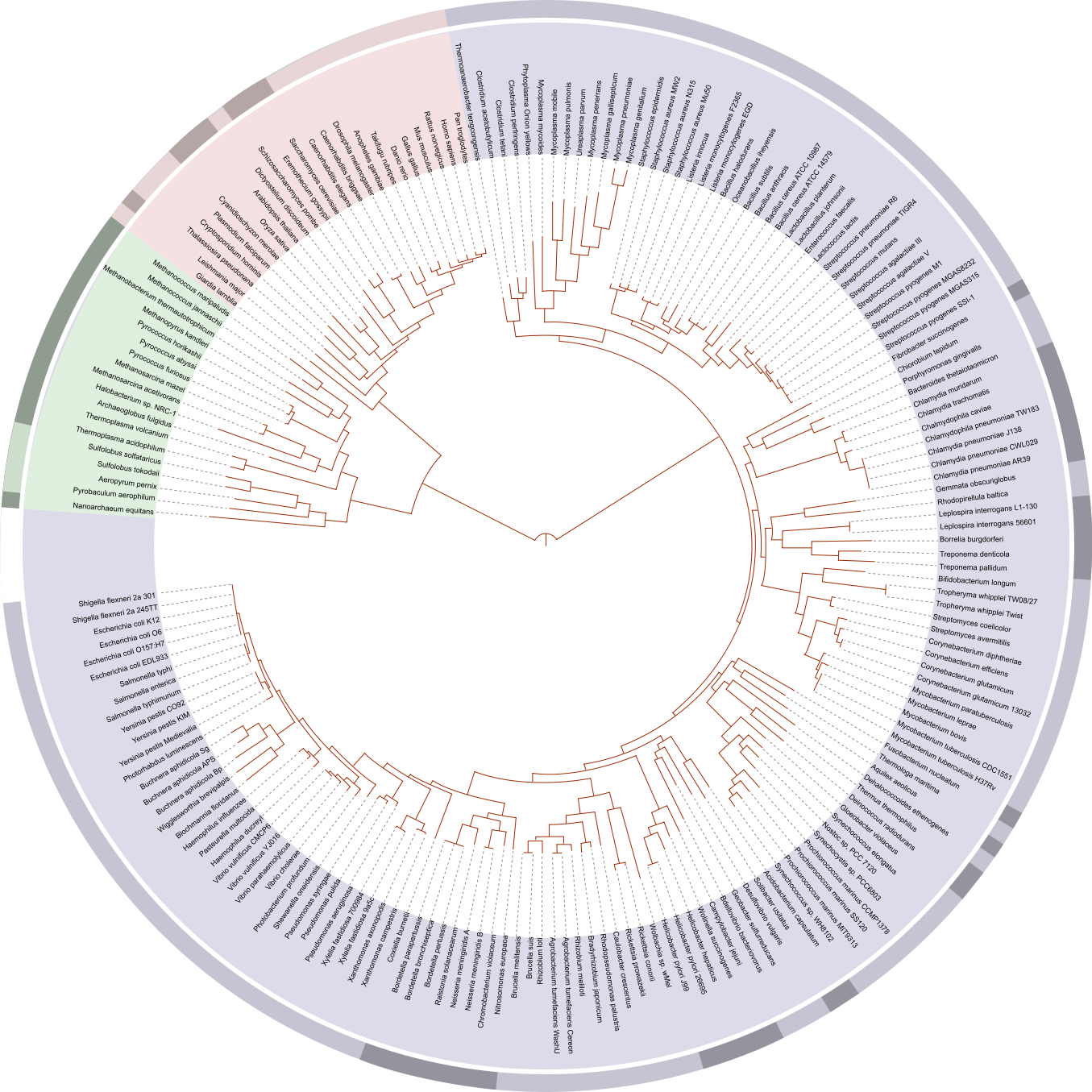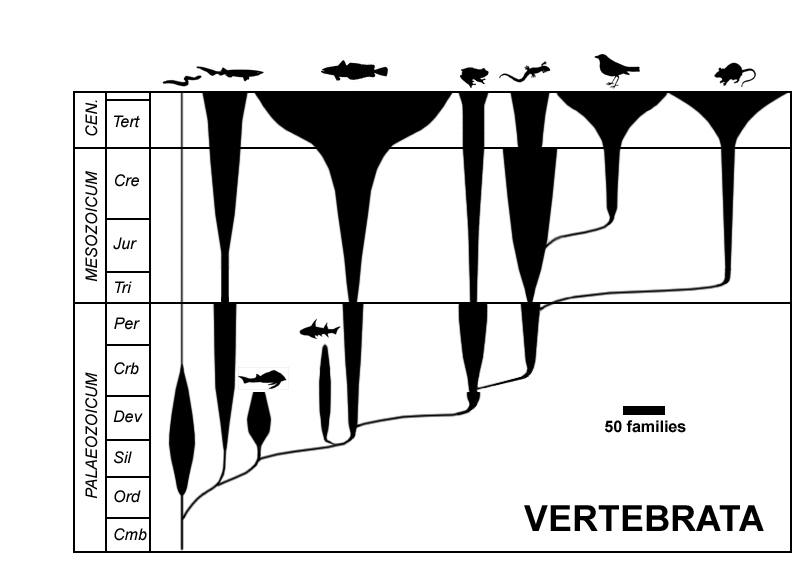New Speciation Model Challenges Evolution, Supports Creation
Which model, naturalistic evolution or supernatural creation, best explains the pattern of life’s history on Earth? If a test produces “strikingly divergent results” for the expectations of a model, what does that tell us? A new study on speciation and extinction rates provides persuasive evidence.
Model Tenets
A fundamental tenet of all naturalistic models for the history of Earth’s life is that natural changes in the genomes of life will be responsible for the observed changes in the physical body structures (morphology) of life. Consequently, evolutionary trees (phylogenies, see figure 1) developed from the observed patterns in present-day genomes and the presumed natural rates of change of those genomes (molecular clocks). Assuming that strictly natural processes are responsible for the changes occurring throughout the history of life, the phylogenetic trees should match the morphological changes and the timing of those changes observed in the fossil record (or paleontological trees—see figure 2).
The same kind of match between the paleontology and phylogenetics can be realized if God intervened throughout life’s history. However, apparently only supernatural interventions can explain significant mismatches between phylogenetic and paleontological trees.

Figure 1: Phylogenetic Tree of Life Derived from Completely Sequenced Genomes. The center represents the presumed first life-form on Earth. The genomes denoted on the outer circle are based on actual genetic data. The branching patterns in the inner circle presume that all species are entirely related to one another through strictly natural processes. Image credit: Ivica Letunic

Figure 2: Spindle Diagram of the Presumed Evolution of Vertebrates. Width of the spindles indicates the number of extant families or the number of families represented in the fossil record. The curved (presumed) connecting lines are not supported by any physical remains. Image credit: Peter Bockman
In an open-access paper published in Nature Communications1, four computational biologists and biochemists led equally by Daniele Silvestro and Rachel Warnock concede:
“The fossil record and molecular phylogenies of living species can provide independent estimates of speciation and extinction rates, but often produce strikingly divergent results.”2
Silvestro, Warnock, and their two colleagues do not concede, however, that supernatural interventions explain the “strikingly divergent results.” They attempt to offer a possible naturalistic explanation.
Divergence Is Real and Striking
Biologists use over a dozen different definitions of a species. In their paper, the Silvestro-Warnock team defines a species as “an identifiable taxonomic unit (a lineage) that can persist through time, give rise to other species, and become extinct.”3
The team first recognizes that since “extant and fossil species are samples of the same underlying diversification process,”4 if the diversification process is by strictly natural means, researchers expect that in all cases the phylogenetic (presumed evolutionary) trees will match the paleontological (fossil record) trees. To put it another way, a match is expected since “methods used to estimate rates [of change] from fossils and phylogenies are based on the same underlying mathematical birth-death theory.”5 The team then documents that evolutionary biologists can no longer deny the frequent and striking divergences between phylogenetic and paleontological trees.
The Silvestro-Warnock team cited a recent study of extant terrestrial Carnivora.6 There, the estimated mean species longevity based on fossil evidence was 2.0 million years, contrasted with 9.8 million years derived from phylogenetics. They also cited a study demonstrating incongruence between phylogenies and fossils for primates.7 They noted that, at least for mammals, the occurrences of congruence are few.8
Speciation rates derived from phylogenetics consistently supersede those derived from the fossil record, while derived extinction rates are consistently lower than speciation rates. Perhaps the best studied example (see featured image) is for cetaceans (whales, dolphins, and porpoises). The Silvestro-Warnock team cited research showing:
“Phylogenetic estimates of diversification rates among cetaceans suggest speciation has exceeded extinction over the past 12 Myr9implying diversity has increased towards the recent. In contrast, analyses of the cetacean fossil record indicate extinction has exceeded speciation over this same interval, and that the diversity of cetaceans was in fact much higher than it is today.”10
In other words, the naturalistic biological evolution model based on phylogenetics predicts that introduction of new species has exceeded extinctions, but the fossil record shows that the reverse is true. The research team did not address the fact that the discrepancies between phylogenetics and the fossil record appear to increase with the complexity and the adult body size of the genus. By contrast, such a correlation is predicted from a biblical creation model perspective for life.11
Silvestro, Warnock and collaborators do point out that several other researchers have attempted to explain the discrepancies by underestimates of the statistical and systematic errors in the two methods. However, the discrepancies in fact are much too large to be attributed to these errors.12
Attempted Reconciliation
The Silvestro-Warnock team suggests that many of the discrepancies between phylogenetics and the fossil record are due to sensitivities to different speciation modes. They identify three distinct modes of speciation that can leave behind fossil evidence without impacting the calculated phylogenetic trees:
- Cladogenesis via budding: a speciation event that gives rise to one new species. The ancestral species persists and no extinction occurs.
- Cladogenesis via bifurcation: a speciation event that gives rise to two new species, replacing the ancestral species, which becomes extinct.
- Anagenetic speciation: evolutionary changes along a lineage that result in the origination of one new species and the extinction of the ancestral species.
They also point out that extinction without replacement is a frequent occurrence, where a species becomes extinct without leaving any descendants. More simply put, the fossil record includes extinct and extant (living) species; whereas phylogenetic data typically include extant species only.
Silvestro, Warnock, and their colleagues developed a model in which they unify budding, bifurcation, anagenesis, and extinction in a single “birth−death chronospecies” (BDC) process. Their BDC model shows that phylogenetic and paleontological speciation and extinction rate estimates will only be equal if all speciation has occurred through budding. Furthermore, they demonstrate that “even in an ideal scenario with fully sampled and errorless data sets, speciation and extinction rates can only be equal across phylogenetic and stratigraphic inferences if all speciation events have occurred through budding and no speciation has occurred through bifurcation or anagenesis”13 (emphasis added). Their BDC model also reveals that phylogenetic analysis indicating extinction equal to zero does not imply that no extinction occurred.
Actual Reconciliation
The team’s BDC model establishes that relative to the fossil record, phylogenetics always underestimates extinction rates. The fossil record, which is largely incomplete, underestimates the true extinction rates. Much higher extinction rates pose a serious challenge to all strictly naturalistic models for Earth’s life because higher extinction rates require higher speciation rates to explain the increasing diversity of life observed in the fossil record throughout life’s history.
This requirement of higher speciation rates is all the more problematic for Earth’s most advanced species. For mammals, birds, and advanced plants, the observed extinction rates far exceed the observed speciation rates during the era of human existence (God’s seventh day when, according to Genesis 2, God ceased from his creation work and allowed natural processes operate).
The Silvestro-Warnock BDC model also exposes a fundamental limitation in naturalistic explanations for the history of Earth’s life. Since all naturalistic models require more than one speciation mode, and since the only way to reconcile phylogenetics and paleontology is to posit just one speciation mode, something other than strictly natural processes must operate.
Some evolutionary biologists will insist on the caveat that perhaps some unknown natural process might salvage a reconciliation between phylogenetics and paleontology. However, it is difficult to conceive how a natural process of sufficient magnitude to reconcile phylogenetics and paleontology could remain undiscovered. It appears to me that a creation model positing that the supernatural Creator intervened at several times throughout life’s history to replace life-forms driven to extinction fully reconciles this “discrepancy.” I am reminded of a verse (Psalm 104:24) from the longest of the creation psalms:
How many are your works, Lord! In wisdom you made them all; the earth is full of your creatures.
Featured image: Nine Different Cetacean Species. Featured image credit: Little Jerry, Creative Commons Attribution
Check out more from Reasons to Believe @Reasons.org
Endnotes
- Daniele Silvestro et al., “Closing the Gap between Palaeontological and Neonotological Speciation and Extinction Rate Estimates,” Nature Communications 9 (December 7, 2018): id. 5237, doi:10.1038/s41467-018-07622-y.
- Silvestro et al., “Closing the Gap,” 1.
- Silvestro et al., “Closing the Gap,” 3.
- Silvestro et al., “Closing the Gap,” 2.
- Silvestro et al., “Closing the Gap,” 2.
- Oskar Hagen et al., “Estimating Age-Dependent Extinction: Contrasting Evidence from Fossils and Phylogenies,” Systematic Biology 67, no. 3 (May 2018): 458–74, doi:10.1093/sysbio/syx082.
- James P. Herrera, “Primate Diversification Inferred from Phylogenies and Fossils,” Evolution 71, no. 12 (December 2017): 2845–57, doi:10.1111/evo.13366.
- Juan L. Cantalapiedra et al., “Congruent Phylogenetic and Fossil Signatures of Mammalian Diversification Dynamics Driven by Tertiary Abiotic Change,” Evolution 69, no. 11 (November 2015): 2941–53, doi:10.1111/evo.12787.
- Daniel L. Rabosky, “Automatic Detection of Key Innovations, Rate Shifts, and Diversity-Dependence on Phylogenetic Trees,” PLoS ONE 9, no. 2 (February 26, 2014): id. E89543, doi:10.1371/journal.pone.0089543.
- Charles R. Marshall, “Five Paleobiological Laws Needed to Understand the Evolution of the Living Biota,” Nature Ecology & Evolution 1 (May 23, 2017): id. 0165, doi:10.1038/s41559-017-0165; Lee Hsiang Liow, Tiago B. Quental, and Charles R. Marshall, “When Can Decreasing Diversification Rates Be Detected with Molecular Phylogenies and the Fossil Record?” Systematic Biology 59, no. 6 (December 2010): 646–59,doi:10.1093/sysbio/syq052; Catalina Pimiento et al., “The Pliocene Marine Megafauna Extinction and Its Impact on Functional Diversity,” Nature Ecology & Evolution 1 (June 26, 2017): 1100–1106, doi:10.1038/s41559-017-0223-6.
- Hugh Ross, More Than a Theory: Revealing a Testable Model for Creation (Grand Rapids: Baker, 2009), 149–79, https://shop.reasons.org/product/269/more-than-a-theory.
- Silvestro et al., “Closing the Gap,” 2.
- Silvestro et al., “Closing the Gap,” 5.





